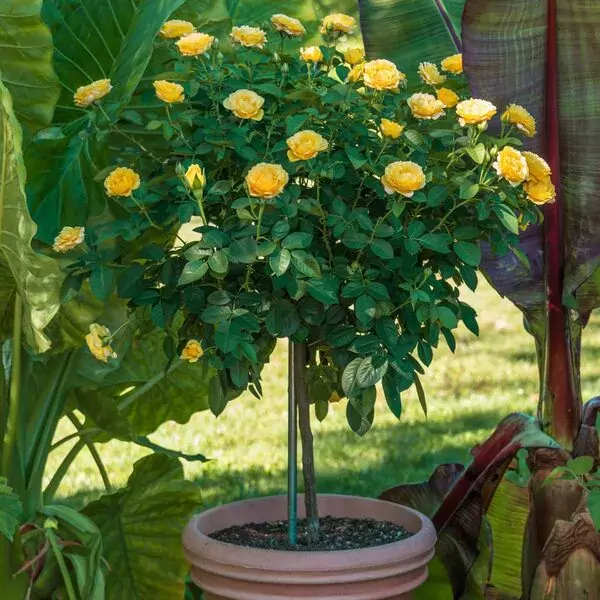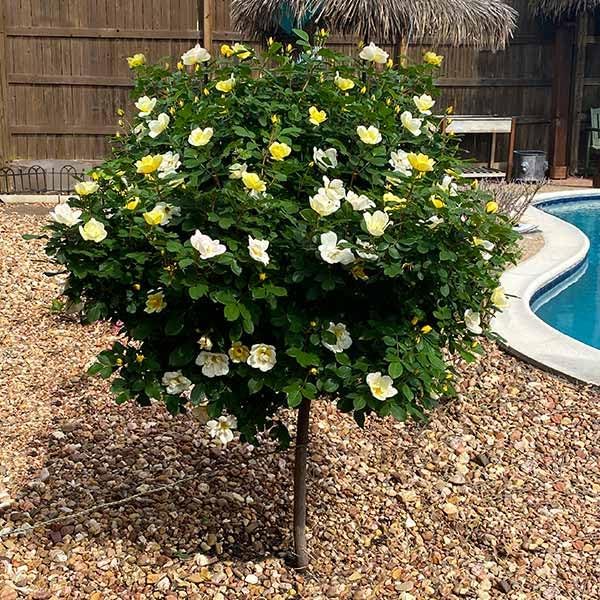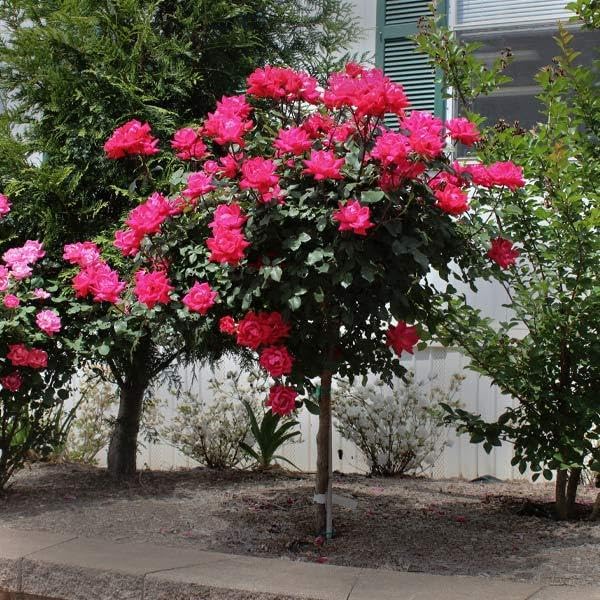A rose is a truly breathtaking and sophisticated ornament of elegance and fragrance for your garden. Unlike its shrub species cousin, the rose tree has a single stem growing straight instead of branched, producing a spectacular flower head at the top.
What is rose plant tree?
The heart and soul of a rose tree is usually a rose plant grown as a variation of the conventional type. Contrary to standard roses, rose trees are a more vertical form of the plant, appearing as tiny trees that carry rose blooms as flowers.
On the other hand, from the gardening perspective, these plants may be trained as bushes, which will grow outside the form they naturally take. Such height is highly diverse, ranging from one foot to eight feet. Another less significant variant is usually the name patio tree roses.
Though any Rosa can be turned into a tree after thoughtful and creative shaping, some variations are better fitted for this training process. Among the most used rootstocks are ‘Dr. Weed types: ‘Huey’ and ‘Manetti’ dog roses (R. canina), wild species, and the hardy perennial R. multiflora. Generally, potential stem sources are either multiflora or R. canina. Most of the top section uses a hybrid of tea, Grandiflora, or floribunda, but other varieties can also be used.
After being potted in separate containers, the roots, stems, and scion are grown independently into the second year. In addition, the plant is subjected to grafting, after which the parts are blended either in the spring or summer of the third year. The standard procedure is to graft two scions on the stem to abuse the more open and strong crown. Take this challenge as well. Be patient and attentive, and you’ll see results. Is it exciting?
How to grow rose tree - Main Principles
No gardening task is as exciting as growing beautiful rose trees. These plants must be carefully cared for to preserve a beautiful state, including pruning, staking, and other specialized treatments.
Selecting the Right Variety: Pick a rose variety that suits your climate and soil conditions. The types of roses commonly used for creating a tree effect are hybrid tea roses and floribunda roses because they have long stems and many flowers.
Site Selection: Select a place with 6-8 hours of sunlight daily and well-draining soil as the primary factor. Provide optimal spacing to create space for the tree to grow and allow for good air circulation.
Planting: To ready the planting hole, loosen the soil by breaking it up and incorporate organic matter like compost. Plant the rose tree at the same degrees as in the nursery container so the graft union is above the soil level.
Gain more knowledge about planting bare-root roses from our comprehensive guide.
Insert a robust stick or metal pipe into the ground beside the standard rose, ensuring it penetrates at least a foot deep. Extend it a few inches above the top graft joint, ideally reaching the bushy head. Tie the tree with soft material to the stick, but not too tightly, to allow your beauty to grow. This will give your young rose tree some support. When the tree gets more robust, the stick can be removed.
How to prune rose tree
Regular pruning is essential to uphold the desired shape of the rose tree and promote robust growth.
Remove dead or diseased branches, and train the remaining stems to grow upward by tying them to a stake or trellis.
During the initial few years, especially for plants with heavy or weeping heads, it’s advisable to prune the head by half in winter to stimulate stem growth. Following the blooming period, light pruning is recommended to maintain their shape and health.
During the late
In winter, trim approximately one-third of the length (adjusting as necessary based on the specific rose type) and eliminate any canes crossing or causing friction.
Important things:
It’s crucial to remember that your rose tree is grafted onto rose hips. While rosehip is undoubtedly a valuable plant, we aim to cultivate roses. One notable characteristic of rosehip is its vigorous growth. It’s imperative to promptly eliminate any growths emerging below the grafting site and surrounding the rose. Neglecting this task could eventually lead to rosehip dominance over your rose plant. Instead of the regal presence of a garden queen, you might find yourself with a robust rosehip plant.
To avert this scenario, it’s essential to trim or remove any new stems that appear beneath the top graft connection as soon as they surface.
I prefer gently pulling the new stems off, as this method removes some of the base, reducing the likelihood of their recurrence.
If the new stems originate from the ground, carefully scrape them. Put the soil away and trim or pull each stem from its base. Afterward, refill the soil and compact it to ensure proper anchorage.
Watering and Feeding:
Ensure a steady supply of moisture to the roots, particularly during dry spells, while being cautious not to overwater, as this can result in root rot. Apply a balanced fertilizer tailored for roses during spring and summer to stimulate healthy foliage growth and prolific blooming.

Get Your Free Lunar Gardener's Calendar 2025!
Join the Lunar Gardening Revolution! Subscribe now to receive our exclusive Free Lunar Gardener’s Calendar for 2025. Harness the power of the moon to optimize your planting, nurturing, and harvesting.
Winter Care Tips:
As winter approaches, rose trees require additional
protection to weather the cold. One method is to encircle the stems with pine boughs or wrap the top and stem with burlap. Employing both methods may be necessary for those residing in exceptionally frigid regions.
Consider pruning the head back by half in colder zones, such as Zone 6 and below. This practice reduces the risk of frost damage or breakage caused by heavy snow accumulation.
Gardeners in areas where winter temperatures plummet below 0°F who are determined to cultivate tree roses have a couple of options. They can plant them in containers for easy indoor relocation or use the trench method during the colder months. To execute the latter, dig up the plant each winter and bury it entirely in a trench approximately a foot deep. Layer the trench with mulch or pine boughs to enhance insulation.
Delve deeper into the nuances of winterizing roses by exploring our guide.
Proper care, love, and nurturing of your rose tree could last over 20 years. Constant care, shrinking back, and pest control determine how long the rose tree will live. Happy gardening!




